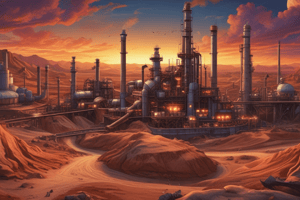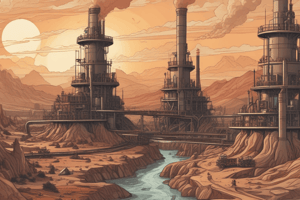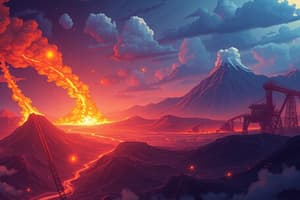Podcast
Questions and Answers
What impact has the increase in fossil fuel consumption had on oil reserves?
What impact has the increase in fossil fuel consumption had on oil reserves?
It has led to the depletion of oil reserves at an alarming rate.
How does natural gas compare to coal in terms of carbon dioxide and air pollutants produced when burned?
How does natural gas compare to coal in terms of carbon dioxide and air pollutants produced when burned?
Natural gas produces around half the carbon dioxide and just one tenth of the air pollutants of coal.
What role can natural gas play in the transition to clean energy sources?
What role can natural gas play in the transition to clean energy sources?
It can help to bridge the journey from fossil fuels to cleaner renewable energy sources.
What is hydel power and how is it generated?
What is hydel power and how is it generated?
Which countries are leading producers of hydel power?
Which countries are leading producers of hydel power?
What is the significance of the water discharged after generating electricity from hydel power?
What is the significance of the water discharged after generating electricity from hydel power?
Which country was the first to develop hydroelectricity?
Which country was the first to develop hydroelectricity?
Where is the world's first solar and wind powered bus shelter located?
Where is the world's first solar and wind powered bus shelter located?
What are the primary products derived from refining crude oil?
What are the primary products derived from refining crude oil?
Why is petroleum referred to as 'Black Gold'?
Why is petroleum referred to as 'Black Gold'?
List some of the chief petroleum-producing countries.
List some of the chief petroleum-producing countries.
What is the role of natural gas in the energy sector?
What is the role of natural gas in the energy sector?
Name the major natural gas reserves in India.
Name the major natural gas reserves in India.
How does compressed natural gas (CNG) benefit the environment?
How does compressed natural gas (CNG) benefit the environment?
What are some industrial applications of natural gas?
What are some industrial applications of natural gas?
What are the Latin origins of the words petroleum and oleum?
What are the Latin origins of the words petroleum and oleum?
What is tidal energy and how is it generated?
What is tidal energy and how is it generated?
Where was the first tidal energy station built?
Where was the first tidal energy station built?
Which countries are known for having large tidal mill farms?
Which countries are known for having large tidal mill farms?
What is biogas and how is it produced?
What is biogas and how is it produced?
What types of organic waste can be converted into biogas?
What types of organic waste can be converted into biogas?
What are the main uses of biogas?
What are the main uses of biogas?
What significant byproduct is produced alongside biogas?
What significant byproduct is produced alongside biogas?
What challenges are associated with harnessing energy from tidal sources?
What challenges are associated with harnessing energy from tidal sources?
What are windmills used for in modern times?
What are windmills used for in modern times?
Where are wind farms commonly located and why?
Where are wind farms commonly located and why?
Name two countries noted for their wind energy production.
Name two countries noted for their wind energy production.
What is the source of nuclear power?
What is the source of nuclear power?
What process occurs in nuclear reactors to produce power?
What process occurs in nuclear reactors to produce power?
Which regions in India have large deposits of uranium?
Which regions in India have large deposits of uranium?
How can a solar cooker be made according to the described activity?
How can a solar cooker be made according to the described activity?
What elements are primarily used as fuel in nuclear power generation?
What elements are primarily used as fuel in nuclear power generation?
What are the two main classifications of minerals based on composition?
What are the two main classifications of minerals based on composition?
How can minerals be identified?
How can minerals be identified?
What are ores?
What are ores?
What distinguishes metallic minerals from non-metallic minerals?
What distinguishes metallic minerals from non-metallic minerals?
What are some characteristics of metals found in metallic minerals?
What are some characteristics of metals found in metallic minerals?
Where are certain minerals often found, as mentioned in the content?
Where are certain minerals often found, as mentioned in the content?
How many different types of minerals are known?
How many different types of minerals are known?
What role do natural processes play in the formation of minerals?
What role do natural processes play in the formation of minerals?
Flashcards are hidden until you start studying
Study Notes
Minerals
- Minerals are natural substances formed through geological processes without human intervention.
- Over 3,000 types of minerals exist, classified as metallic (ferrous and non-ferrous) and non-metallic based on composition.
- Metallic minerals contain metal in raw form, characterized by hardness and conductivity.
- Ores are rocks from which minerals are extracted, lacking a definite composition.
Petroleum and Natural Gas
- Petroleum, also known as "black gold," is processed into various products including diesel, petrol, and plastics.
- Major petroleum-producing countries include Iran, Iraq, Saudi Arabia, and Qatar, with the USA, Russia, Venezuela, and Algeria as significant contributors.
- In India, major petroleum sources are found in Digboi, Bombay High, and river deltas of Krishna and Godavari.
- Natural gas is typically found alongside petroleum and serves as a clean energy resource with diverse applications.
- Leading global producers of natural gas are the USA, Russia, Iran, Qatar, and China; major reserves in India are located in Mumbai High, Krishna Godavari, Cambay, Tripura, and Assam.
- Natural gas emits fewer pollutants compared to coal and fossil fuels, making it a cleaner option for energy generation.
Hydel Power
- Hydel power is generated through the gravitational force of falling water, underscoring the use of dams to store and release water.
- Paraguay, Norway, Brazil, and China are the leading producers of hydel power globally.
- Important hydel power stations in India include Bhakra Nangal, Gandhi Sagar, Nagarjunsagar, and the Damodar Valley projects.
Wind Energy
- Wind energy is produced by using windmills that harness wind power to generate electricity.
- Wind farms are typically located in coastal and mountainous regions with consistent high-speed winds.
- Key countries in wind energy production include the Netherlands, Germany, Denmark, the UK, the USA, and Spain.
Nuclear Power
- Nuclear power is derived from fission processes of radioactive elements like uranium and thorium.
- The USA and Europe are major producers of nuclear energy, with large deposits of uranium located in India, particularly in Rajasthan and Jharkhand.
Tidal Energy
- Tidal energy is generated from the movement of tides by constructing dams at sea openings.
- Major tidal energy sources are found in Russia, France, and the Gulf of Kachchh in India.
Biogas
- Biogas is produced by decomposing organic waste in biogas digesters, resulting in a mixture of methane and carbon dioxide.
- It is an effective fuel for cooking and lighting and supports the production of organic manure.
- Energy harnessing remains a complex and costly challenge despite the abundance of available resources.
Studying That Suits You
Use AI to generate personalized quizzes and flashcards to suit your learning preferences.




